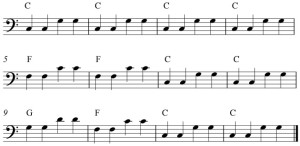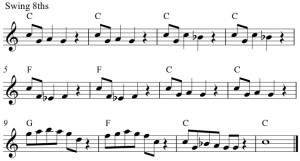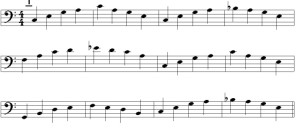It’s fun and easy to improvise with the blues on your harp. The traditional blues progression is really quite easy. It consists of 12 bars in 4/4 time with a set progression. The simplest traditional chord progression is
I I I I
IV IV I I
V IV I I.
In the key of C, that would be
C C C C
F F C C
G F C C.
To keep that steady blues beat, you play the chord on all 4 beats of each bar, so you might think of it like this:
CCCC CCCC CCCC CCCC
FFFF FFFF CCCC CCCC
GGGG FFFF CCCC CCCC
Playing straight chords on every beat is tiring and can sound muddy on the harp, so it’s better to play open chords or alternate between the root and the other two notes from one beat to the next. To begin with, try playing just the chord roots (the note C for four measures, and so on).
Here’s another easy alternative that keeps the steady beat and is harp-friendly (click image for larger version):

Right now, your goal is to play something in your left hand so simple that you can keep it going while you improvise with your right hand. So stick with chord roots if this pattern is too much to remember right now.
With your right hand, play only notes that are part of the chords you’re playing or even just play the chords twice on beat one and then rest for three measures.
If you’re an intermediate player, and that feels easy, you can get fancier. Remember, though, that the blues is very repetitive; you might only play on beats one and two with your right hand, for exmaple, and play a similar rhythmic pattern for every measure.
Here’s another intermediate idea:

Now, you may have noticed I put some flats in there. If you know your chords, you’ll notice that some of the chords have become dominant sevenths in the process, though I haven’t marked them that way to keep things as simple as possible. If I’ve lost you, just go back to the easy level of this improvisation play chord roots in your left hand, play sparingly and without flats in your right hand, and have fun!
For those of you who want a little more depth, I’m going to explain a bit more. The thing that gives the blues its jazzy flavor is the blues scale, which also includes several flats. Here is the whole blues scale in the key of C (click any image for a larger version):

The blues notes add the pizazz, but notice that their natural counterparts are also part of the scale. What’s a lever harpist to do?
For starters, on most lever harps, we need to use F# instead of Gb. Fortunately, the Gb is the least important blue note, so feel free to leave it out or save it for occasional punch.
You really need to play B-natural on the G chord and E natural on the C chord. One of my favorite ways to play the right hand is to put the Bb and Eb in the middle octave (right above middle C) and play with my RH in that octave when I’m on the F chord, but play up an octave to catch the naturals when I’m on the G chord. On the C chord, I also play up an octave so that I’m avoiding Eb, but I catch the Bb sometimes from just below that C. This is far simpler than it sounds and far easier than flipping levers all the time. (My right hand pattern above works this way).
If you’re up for a challenge, or you’re an advanced player, you can experiment with lever slides to ramp up the variations between the flats and naturals. If you get bored and ready for something different in your left hand, you try playing with the traditional blues bass line

To make the bass line more playable, play every note with your thumb (with the thumbs-up position) and play C instead of Bb. (You can keep the Eb if you’ve set that in the middle register for your RH anyway). You may want the play the first two measures on line 3 up an octave higher, especially if you have a small harp. In that case, either leave the Eb out (play F), or play simple G and F broken triads in those measures (G B D B, F A C A).
If you’re struggling, go back to the easy chords and keep that beat going. The RH can really be so simple–play 2 eighth notes on beat one and then rest for the remainder of the bar and you’ll be in the blues groove. And if you have a playing partner, take turns: one person can play the chords while the other “solos”.
Have fun!
This post is adapted from material that I originally published in the ezine, Notes from the Harp.








